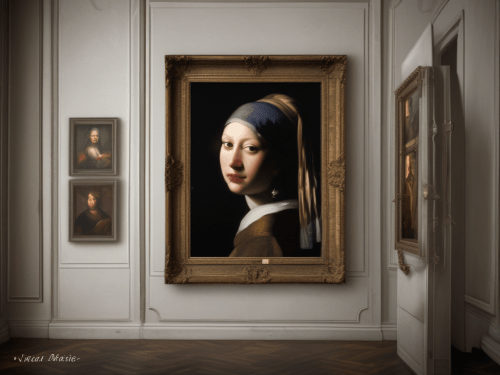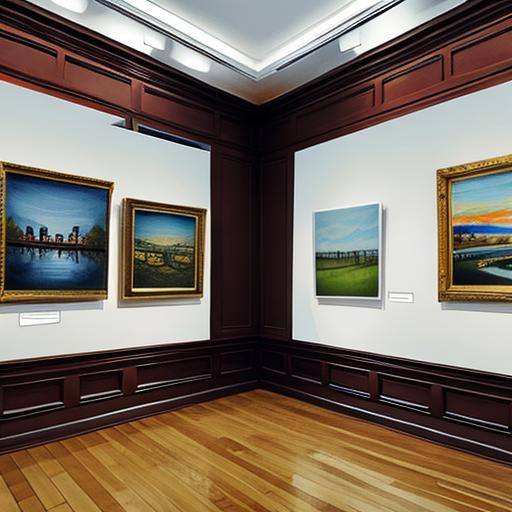Have you ever looked at a painting – maybe splashes of color, a detailed portrait, or a dreamy landscape – and wondered, “Why is this worth so much money?” It can seem like a mystery, especially when some artworks sell for millions! The truth is, figuring out what makes paintings valuable isn’t about a secret code, but it does involve a fascinating mix of different factors. It’s not just about how pretty a picture is; it’s about the story behind it, who made it, its history, and even what’s popular right now. Let’s pull back the curtain and explore the intriguing world of art valuation together.
Key Points Summary:
- Artist Reputation: Famous, skilled, and historically important artists command higher prices.
- Provenance: The painting’s documented ownership history proves authenticity and adds to its story.
- Condition: Well-preserved paintings are worth more than damaged or poorly restored ones.
- Rarity: Unique works or those from limited periods/series are more valuable.
- Historical/Cultural Significance: Paintings tied to important movements or moments gain value.
- Aesthetic Quality/Subject: Beauty, skill, and desirable subjects play a role, though this can be subjective.
- Medium/Materials: Quality materials and certain techniques can influence perceived value.
- Art Market Dynamics: Current trends, gallery representation, and auction buzz heavily impact price.
Notable Painting Auction Prices
| Painting | Artist | Price (USD) | Year Sold | Key Value Factors |
|---|---|---|---|---|
| “Salvator Mundi” | Leonardo da Vinci | $450.3 million | 2017 | Extreme rarity, artist’s reputation, historical significance |
| “Interchange” | Willem de Kooning | $300 million | 2015 | Artist’s role in abstract expressionism, large scale, critical acclaim |
| “The Card Players” | Paul Cézanne | $250 million | 2011 | Part of famous series, artist’s influence on modern art, rarity |
| “Nafea Faa Ipoipo (When Will You Marry?)” | Paul Gauguin | $210 million | 2014 | Artist’s reputation, subject matter (Tahitian period), vibrant colors |
| “Number 17A” | Jackson Pollock | $200 million | 2015 | Revolutionary technique, abstract expressionism movement |
| “No. 6 (Violet, Green and Red)” | Mark Rothko | $186 million | 2014 | Artist’s reputation in color field painting, emotional impact |
| “Pendant Portraits of Maerten Soolmans and Oopjen Coppit” | Rembrandt | $180 million | 2015 | Old Master status, historical significance, rarity of paired portraits |
| “Les Femmes d’Alger (Version O)” | Pablo Picasso | $179.4 million | 2015 | Artist’s fame, part of important series, vibrant composition |
| “Nu Couché” | Amedeo Modigliani | $170.4 million | 2015 | Artist’s unique style, rarity of nude paintings in his oeuvre |
| “Three Studies of Lucian Freud” | Francis Bacon | $142.4 million | 2013 | Triptych format, connection between renowned artists, emotional intensity |
Note: Some sales were private and the exact prices may be approximate. All prices are in US dollars.
The Artist: More Than Just a Name

Think about famous names you know – Leonardo da Vinci, Pablo Picasso, Vincent van Gogh, or even contemporary stars like Jean-Michel Basquiat. Why are their works so expensive?
- Fame and Recognition: Simply put, artists who are household names have higher demand. Museums want their work, collectors compete for it, and this drives up prices. Their reputation is built over time, often long after they’re gone.
- Skill and Innovation: Was the artist a master of their craft? Did they invent a new style or technique, like the Impressionists (Claude Monet) changing how light was painted, or Picasso shattering forms in Cubism? Pushing boundaries adds value.
- Historical Importance: Artists who captured a moment in time, influenced other artists, or represented a major art movement (like the Renaissance or Pop Art) often have works considered more significant, and thus, valuable.
- Output: Some artists produced thousands of works, while others created very few. Scarcity plays a role here too.
Often, the very signature on the canvas, perhaps applied with thick, textured paint, becomes a symbol of this reputation and authenticity – a direct link to the creator’s hand and a key indicator of potential worth.
Provenance: The Painting’s Pedigree
Imagine finding an old painting in your attic. How would you know if it’s a lost masterpiece or just a nice decoration? This is where provenance comes in. It’s like a painting’s biography or resume.

Provenance is the documented history of who has owned the painting, right back to the artist’s studio if possible. It can include:
- Original bills of sale
- Letters mentioning the artwork
- Exhibition catalogues where it was shown
- Previous owner records
- Certificates of Authenticity
Why is this so important? A solid provenance helps prove the painting is authentic (the real deal, not a fake) and tells its unique story. Picture an old, perhaps slightly faded painting resting beside aged documents – letters with looping script, official-looking seals, maybe an old auction catalog. A magnifying glass hovering nearby suggests the careful investigation required to trace this history. A painting once owned by a famous collector or exhibited at a major museum like The Metropolitan Museum of Art often carries more weight and, therefore, more value because of this traceable lineage. Lack of provenance can raise doubts and significantly lower the price. This paper trail is a crucial element in understanding what makes paintings valuable.p
Condition: Is it Picture Perfect?
Like anything old, paintings can show their age. Condition refers to the physical state of the artwork. Factors include:

- Damage: Tears, holes, scratches, flaking paint, or water damage can drastically reduce value.
- Fading: Colors can fade over time, especially if exposed to too much light.
- Restoration: Has the painting been repaired? Good conservation, done by experts, can preserve value. Bad restoration (overpainting, harsh cleaning) can destroy it. Think of it like maintaining a classic car – careful upkeep retains value, while neglect or bad repairs lower it.
- Original State: Ideally, collectors want a painting as close to its original condition as possible.
Visualizing an art conservator, perhaps wearing gloves and working meticulously under bright light, carefully cleaning or examining a small section of an older, ornate painting, underscores the importance of this factor. Their careful touch highlights how expert care preserves value. Serious buyers will often request a Condition Report from a professional art conservator before purchasing. This detailed examination highlights any issues. A pristine condition is a major plus when assessing art valuation factors. Need tips on keeping your art safe? Check out The Complete Guide to Art Preservation.
Rarity and Uniqueness: One of a Kind?
How many paintings like this one exist? Rarity is a simple concept: the harder something is to find, the more people might want it.

- Limited Output: Some artists naturally produced fewer works.
- Specific Periods: An artist might have a ‘golden period’ where their work was exceptional. Paintings from this time are often more sought-after.
- Unique Works: Is it a one-off painting, or part of a series of prints or multiples? Original, unique paintings are generally the most valuable.
- Lost or Destroyed Works: If many works by an artist have been lost over time, the remaining ones become even rarer.
Imagine a stark, minimalist art gallery. On a large white wall, illuminated by a single spotlight, hangs one compelling, perhaps abstract, painting. Its isolation emphasizes its singularity. Being the only one, or one of very few, makes a painting exclusive and highly desirable for collectors trying to own a piece of history.
Historical and Cultural Significance: Capturing the Zeitgeist
Some paintings are valuable not just for their beauty, but because they represent something bigger.
- Art Movements: Does the painting perfectly capture a key art movement, like Surrealism, Abstract Expressionism, or the boldness of the Dada art movement? Being a textbook example adds importance.
- Historical Context: Was the painting created during a major historical event? Does it depict an important figure or moment? Does it comment on social issues? Art that connects to history often gains significance over time. Art for change often resonates deeply.
- Cultural Impact: Did the painting influence culture, fashion, or other artists? Did it spark conversation or controversy? Think of Andy Warhol’s soup cans – they commented on mass production and became icons of Pop Art.
A painting that tells a story about its time or changes the way people think often achieves lasting value.
Aesthetic Quality and Subject Matter: The Beauty Factor
Okay, does the painting actually look good? This is maybe the most subjective factor, but it still matters.
- Visual Appeal: Is the painting generally considered beautiful, striking, or emotionally engaging? While tastes differ, certain compositions, color harmonies, and skillful executions often have broader appeal.
- Skillful Execution: Does the painting show technical mastery? Whether it’s hyperrealism or expressive abstraction, the artist’s skill in handling their chosen medium (like oil paint, watercolor, or acrylic) is usually evident. Check out guides for mastering acrylic painting or watercolor techniques.
- Desirable Subject: Historically, certain subjects (like grand portraits, classical myths, serene landscapes) were more fashionable than others (like scenes of everyday life). Today, tastes are broader, but subject matter can still influence desirability for certain collectors.
While “beauty is in the eye of the beholder,” technical skill and general aesthetic appeal are definitely part of what makes paintings valuable.
Medium and Materials: What’s it Made Of?
While maybe less critical than the artist or provenance, the materials used can play a part:
- Durability: Oil paintings on canvas or wood panels tend to last longer than, say, watercolors on paper, which can factor into long-term value perception.
- Prestige: Historically, oil painting was considered the most prestigious medium. While this is less rigid now, large oil paintings often carry an inherent sense of importance.
- Complexity: Some techniques are more difficult or time-consuming than others, which can sometimes translate to higher value.
It’s usually not the deciding factor, but the medium contributes to the painting’s overall presence and longevity.
The Art Market: Buzz, Trends, and Gatekeepers
A painting’s value isn’t set in stone; it fluctuates within the art market. This complex system includes:

- Galleries: Prestigious galleries (like Gagosian or David Zwirner) discover, promote, and represent artists. Getting shown in top galleries boosts an artist’s reputation and prices. See insights on influential art galleries.
- Auction Houses: Major players like Christie’s and Sotheby’s hold high-profile auctions where record prices are often set. Auction results create buzz and influence market perceptions of value.
- Collectors: Demand from wealthy individuals, museums, and investment funds drives prices. What collectors are looking for right now heavily influences the market.
- Critics and Curators: Positive reviews and inclusion in major museum shows add validation and prestige.
- Market Trends: Like fashion, the art world has trends. Certain styles or artists might be “hot” for a period, driving up their prices. Keeping an eye on art market trends is key for collectors.
The dynamic energy of a high-end art auction – the elegant room, the focused bidders raising paddles, the auctioneer presiding, all centered around a brilliantly lit painting – perfectly illustrates how market forces and collective excitement shape value in real-time. This market aspect explains why prices can sometimes seem illogical – high demand and buzz can inflate value significantly.
What Makes Paintings Valuable in Today’s Market?
So, bringing it all together, what makes paintings valuable today is a blend of all these elements. While the traditional factors like artist reputation, condition, and provenance remain crucial (‘blue-chip’ art holds value well), the contemporary market adds layers:
- Global Demand: Buyers come from all over the world, increasing competition for top pieces.
- Investment Potential: Art is increasingly seen as an asset class, with people buying for potential financial return, not just love of the art.
- Social Media & Online Presence: Buzz can be generated faster than ever. Artists gain followings online, influencing desirability. Check out how TikTok is shaping contemporary painting styles.
- Focus on Underrepresented Artists: There’s growing interest and market correction for works by women artists and artists of color who were historically overlooked.
It’s a dynamic mix of tangible quality and intangible perception.
“The value of art is not intrinsic; it is determined by the beliefs of the people who buy and sell it.” – Unknown (but widely cited idea in the art market)
The “It” Factor: Magic and Mystery
Sometimes, a painting just captures the public imagination. It has that hard-to-define “It” factor. Maybe it’s an incredible backstory, a connection to a beloved figure, or just an image that resonates deeply across cultures. Think of the Mona Lisa – its theft in 1911 dramatically increased its fame and perceived value beyond just the skilled painting itself. This emotional connection and cultural resonance can add a layer of value that’s hard to quantify but undeniably real.
Summary Table: Key Factors Influencing Painting Value
| Factor | Description | Impact on Value |
| Artist Reputation | Fame, skill, innovation, historical importance. | High (Often the most significant factor) |
| Provenance | Documented ownership history. | High (Crucial for authenticity & desirability) |
| Condition | Physical state, damage, restoration quality. | High (Poor condition drastically reduces value) |
| Rarity | Uniqueness, limited output from the artist. | High (Scarcity increases demand) |
| Significance | Historical/cultural context, ties to movements. | Medium to High (Adds depth and importance) |
| Aesthetic/Subject | Visual appeal, skill, desirable theme. | Medium (Subjective but influences desirability) |
| Medium/Materials | Oil, watercolor, canvas, paper, etc. | Low to Medium (Affects longevity & perception) |
| Art Market | Gallery/auction buzz, trends, collector demand. | High (Drives current prices significantly) |
Conclusion: A Complex Equation
As we’ve seen, pinpointing exactly what makes paintings valuable involves looking at many different pieces of a complex puzzle. It’s a blend of the artist’s genius, the artwork’s history and condition, its rarity, its cultural importance, and the ever-shifting currents of the art market. There’s no simple calculator (art price calculators often struggle with these nuances). Understanding these factors helps demystify those headline-grabbing auction prices and allows for a deeper appreciation of the incredible stories and human effort captured within each frame. Whether you’re a budding collector, an art student, or just curious, knowing these secrets unlocks a richer understanding of the art world’s fascinating dynamics.
Frequently Asked Questions (FAQ)
Q1: How do you know if a painting is valuable?
A: Look at several factors: Who is the artist (are they known/listed)? What is the painting’s condition? Does it have provenance (history of ownership)? Is it rare or unique? Is the quality high? Researching the artist and similar works sold at auction can give clues. For a definite answer, consult a professional art appraiser.
Q2: What type of paintings are worth money?
A: Paintings by famous, historically significant artists (‘Old Masters’ like Rembrandt, Impressionists like Monet, Modern masters like Picasso, established Contemporary artists) tend to be worth the most. Works with strong provenance, in excellent condition, and representing key moments in the artist’s career or art history are highly valued. However, emerging artists can also become valuable over time.
Q3: How can I find out the value of my artwork?
A: While online searches for similar works can give a rough idea, the best way is to consult a certified art appraiser. They have the expertise to evaluate all the factors (artist, condition, provenance, market) and provide a formal valuation. Auction houses like Sotheby’s or Christie’s sometimes offer initial free estimates.
Q4: What makes art expensive?
A: It’s a combination of factors discussed above: High demand for works by famous artists, proven rarity and authenticity (provenance), excellent condition, historical significance, and the competitive nature of the art market (auctions, gallery influence, collector interest, investment potential). It’s driven by both intrinsic qualities and market forces.
Q5: Do paintings increase in value over time?
A: Not necessarily. While works by established artists often appreciate over the long term, art value can fluctuate based on market trends, the artist’s changing reputation, and economic conditions. Art bought purely for investment carries risk. Buying art you love is often the best approach.
Q6: What is the most expensive painting ever sold?
A: As of recent records, Leonardo da Vinci’s “Salvator Mundi” holds the record for the most expensive painting sold at public auction (around $450 million USD in 2017). Private sales might have involved higher figures, but they are not always publicly disclosed.



